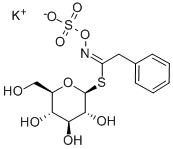SodiuM new houttuyfonate
- CAS NO.:83766-73-8
- Empirical Formula: C12H25NaO5S
- Molecular Weight: 304.38
- MDL number: MFCD09029429
- EINECS: 255-836-0
- Update Date: 2024-11-18 17:01:59

What is SodiuM new houttuyfonate?
Description
For 50 years, the surfactant dodecyl sodium sulfoacetate has been used in a variety of applications, such as foams in petroleum production, adhesives, oral hygiene products, and denture detergents. But in the past decade, thanks to Chinese herbal medicine, it acquired a new name and is being studied as a bactericide.
Houttuynia cordata is an East Asian flowering plant known in English as fish mint, lizard tail, chameleon plant, and several other names. In Vietnam, India, and China, it is consumed as a vegetable or a garnish. Its use in traditional Chinese medicine to treat pneumonia and, more recently, SARS is limited by its tendency to produce severe allergic reactions when injected.
The active ingredient in H. cordata has been identified as houttuynin, or 3-oxododecanal. This aldehyde is chemically unstable, leading researchers to prepare stable derivatives to explore potential medicinal uses. One of these derivatives is dodecyl sodium sulfoacetate, which for this purpose is called sodium new houttuyfonate (SNH). SNH and its cousin, sodium houttuyfonate (sodium 1-hydroxy-3-oxo-1-dodecanesulfonate), have been approved by the China Food and Drug Administration for treating respiratory tract infections (pneumonia and bronchitis) and skin infections.
Earlier this year, Yunlong Pan, Qing-Yu He, and colleagues at Jinan University (China) reported the use of an iTRAQ-based proteomic method to establish the mechanism that SNH uses to kill the pneumonia bacterium Streptococcus pneumoniae. (iTRAQ is the labeling technique "isobaric tags for relative and absolute quantitation".) The researchers found that SNH upregulates several proteins in S. pneumoniae that produce reactive oxygen species. Specifically, they found that H2O2 produced from the upregulation kills S. pneumoniae in a dose-dependent manner.
So before you dismiss sodium new houttuyfonate as one of those chemicals with a weird name, keep in mind that traditional Chinese medicine directed investigators to a potential cure for pneumonia.
The Uses of SodiuM new houttuyfonate
Sodium Houttuyfonate is an inhibitor of inflammatory responses. It also has antibacterial activity. It is also a surfactant.
Properties of SodiuM new houttuyfonate
| Melting point: | 159 - 162°C |
| storage temp. | -20°C Freezer, Under inert atmosphere |
| solubility | DMSO (Sparingly, Heated), Methanol (Slightly, Heated) |
| form | Solid |
| color | White to Off-White |
Safety information for SodiuM new houttuyfonate
Computed Descriptors for SodiuM new houttuyfonate
New Products
4-AMINO-TETRAHYDRO-PYRAN-4-CARBOXYLIC ACID HCL 4-(Dimethylamino)tetrahydro-2H-pyran-4-carbonitrile 4-Aminotetrahydropyran-4-carbonitrile Hydrochloride (R)-3-Aminobutanenitrile Hydrochloride 3-((Dimethylamino)methyl)-5-methylhexan-2-one oxalate 1,4-Dioxa-8-azaspiro[4.5]decane 5-Bromo-2-nitropyridine Nimesulide BP Aceclofenac IP/BP/EP Diclofenac Sodium IP/BP/EP/USP Mefenamic Acid IP/BP/EP/USP Ornidazole IP Diclofenac Potassium THOMAIND PAPER PH 2.0 TO 4.5 1 BOX BUFFER CAPSULE PH 9.2 - 10 CAP SODIUM CHLORIDE 0.1N CVS ALLOXAN MONOHYDRATE 98% PLATINUM 0.5% ON 3 MM ALUMINA PELLETS (TYPE 73) LITHIUM AAS SOLUTION 2-Bromo-1-(bromomethyl)-3-chloro-5-nitrobenzene 2-Bromo-3-nitroaniline N-(3-Hydroxypropyl)-N-methylacetamide 3-Bromo-6-chloropyridazine 4-ethyl-3-nitrobenzoic acidRelated products of tetrahydrofuran





![(2R)-2,3-Bis[[(9Z,12Z)-1-oxo-9,12-octadecadien-1-yl]oxy]propyl beta-D-galactopyranoside](https://img.chemicalbook.in/CAS/20150408/GIF/111187-15-6.gif)


You may like
-
 1-Methyl-6-oxo-1,6-dihydropyridazine-3-carbonitrile 98%View Details
1-Methyl-6-oxo-1,6-dihydropyridazine-3-carbonitrile 98%View Details
99903-60-3 -
 88491-46-7 98%View Details
88491-46-7 98%View Details
88491-46-7 -
 1823368-42-8 98%View Details
1823368-42-8 98%View Details
1823368-42-8 -
 2-(3-(tert-butyl)phenoxy)-2-methylpropanoic acid 1307449-08-6 98%View Details
2-(3-(tert-butyl)phenoxy)-2-methylpropanoic acid 1307449-08-6 98%View Details
1307449-08-6 -
 Ethyl 3-(furan-2-yl)-3-hydroxypropanoate 25408-95-1 98%View Details
Ethyl 3-(furan-2-yl)-3-hydroxypropanoate 25408-95-1 98%View Details
25408-95-1 -
 2-Chloro-5-fluoro-1-methoxy-3-methylbenzene 98%View Details
2-Chloro-5-fluoro-1-methoxy-3-methylbenzene 98%View Details
1805639-70-6 -
 1784294-80-9 98%View Details
1784294-80-9 98%View Details
1784294-80-9 -
 Lithium ClavulanateView Details
Lithium ClavulanateView Details
61177-44-4